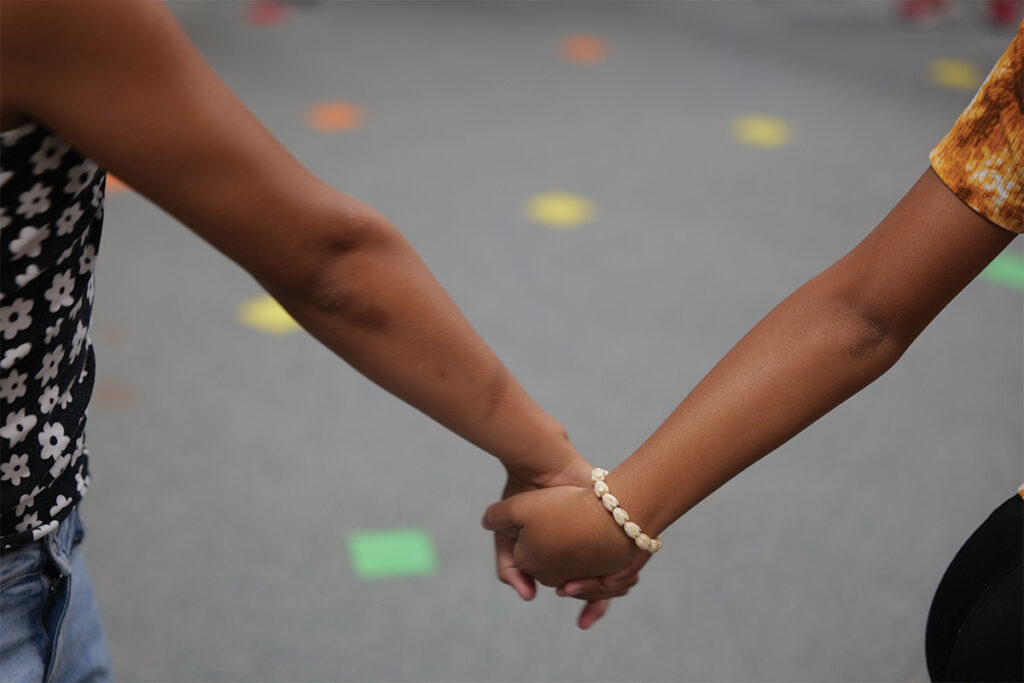Our Hawaiʻi public schools believe every student deserves a safe, respectful learning environment—both in school and online. Pagdaogdaog, in any form, undermines the well-being and success of students. That’s why we are committed to empowering students, families and communities with tools and resources to prevent and address bullying. From proactive prevention programs to easy-to-use reporting tools like the Speak Now HIDOE app, nakigtambayayong kami sa among mga komunidad aron mapalambo ang kultura sa pagtahod, responsibilidad ug empatiya. Mag-uban, atong masiguro nga ang matag estudyante mobati nga gisuportahan ug luwas, aron sila molambo sa akademiko ug emosyonal.

What is Pagdaogdaog?
Pagdaogdaog is a serious issue that affects students of all ages and backgrounds. While there are many forms of bullying, we’ll be focusing on two primary categories: bullying ug cyberbullying. Understanding these two types is important so we can all work together to create a safer and more respectful school environment.
“Bullying”—bisan unsang sinulat, verbal, graphic, o pisikal nga buhat nga makapasakit, makadaut, makapakaulaw o makahadlok sa usa ka estudyante, lakip na kadtong adunay giprotektahan nga mga kahimtang sa klase, nga igo nga grabe, makanunayon, o kaylap nga nagmugna kini usa ka makahadlok, mahulga, o abusado nga palibot sa edukasyon.
“Cyberbullying”—electronically transmitted acts, including but not limited to those transmitted through the Internet, cell phone, or other wireless hand-held device initiated by one student toward another student or employee of the department that hurts, harms, humiliates, or intimidates the student or employee; and is sufficiently severe, persistent or pervasive, that it creates an intimidating, threatening, or abusive educational environment. Cyberbullying can occur:
- Sa campus, o ubang lugar sa departamento, sa transportasyon sa departamento, o sa panahon sa kalihokan o kalihokan nga gipasiugdahan sa departamento sa sulod o sa gawas sa eskuylahan;
- Pinaagi sa usa ka sistema sa datos sa departamento nga walay awtorisado nga komunikasyon sa departamento; o
- Pinaagi sa usa ka network sa kompyuter sa gawas sa kampus, kung ang paggawi makaapekto sa palibot sa edukasyon.
Additionally, cyberbullying may also be based on a person’s protected class, including but not limited to, a person’s race, color, religion, sex, sexual orientation, gender identity, gender expression, age, national origin, ancestry, disability, physical appearance and characteristics, and socio-economic status.
ReporT bullying with our App
HIDOE has an app that allows students to report bullying incidents. Our Pakigsulti Karon HIDOE Reporting App offers elementary, middle and high school students a way to report bullying incidents—digitally and anonymously, if they choose—that happen on campus, on HIDOE transportation, or at HIDOE-sponsored events.
- Tan-awa ang mga video sa ubos para sa sunod-sunod nga pasundayag kon unsaon pagsumite ug tip gamit ang app.
- Pakigsulti Karon HIDOE Reporting App Flyer (PDF)
Unsaon Pagsumite ug Tip
Mga Estudyante sa Sekondarya sa Grade 7-12
Mga Estudyante sa Elementarya sa Grade 4-6
managing bullying
Pagdaogdaog is a Community Issue
Pagdaogdaog belongs to all of us. School staff can address incidents and support students at school, but they cannot stop bullying—in all its forms, and in all the places it occurs—on their own. Families, students, and communities have a role to play to adopt and promote a culture of respect, responsibility and resiliency.
Among giawhag ang mga pamilya sa pagpakigsulti sa ilang mga anak mahitungod sa pagkamatinahuron ug pagkamabination ngadto sa uban, lakip niadtong lahi sa ilang kaugalingon. Sa among mga eskuylahan, among giugmad kini nga mga kinaiya isip bahin sa Nā Hopena Aʻo, social-emotional learning, and other efforts. While bullying can happen to anyone, students may also be targeted because of race, socio-economic status, sexual orientation, gender identity, learning disabilities and other qualities; a violation of mga balaod sa katungod sa sibil.
Community-wide strategies can help identify and support children who are bullied, redirect the behavior of children who bully, and change the attitudes of adults and youth who tolerate bullying behaviors in peer groups, schools, families and communities.
Any child who is bullied or who witnesses a bullying incident is encouraged to tell a trusted adult or report it using the Speak Now HIDOE app. If an incident happens on our school campuses, on HIDOE transportation, or during a HIDOE-sponsored event, appropriate school personnel will investigate.
Our Response to Pagdaogdaog
- Paglikay: All schools are invested in building a positive school culture and climate to encourage all students to be respectful and empathetic. To address bullying behaviors schools may be implementing one or more of the following:
- Kinatibuk-ang eskuylahan nga positibo nga pamatasan nga mga pamatasan nga nagtudlo sa mga estudyante nga mahimong matinahuron, responsable ug mabination nga mga estudyante.
- Anti-Bullying Programs: Communities are unique, and schools have different approaches based on their community’s needs. Some schools have students leading their anti-bullying efforts.
- Mga Pakig-uban sa Komunidad: Daghang mga eskwelahan ang nag-ugmad ug mga relasyon sa mga ahensya sa komunidad, mga tighatag sa kahimsog ug kahimsog, mga grupo sa polisa ug mga polis sa komunidad, mga legal nga magtatambag, mga practitioner sa kultura ug uban pa aron mapalapad ang mga suporta.
- tubag: Kung mahitabo ang usa ka insidente, ang prinsipal o ang iyang gitudlo nga mag-imbestiga sa:
- Tinoa kung usa ka paglapas nga gipasabut sa Hawaiʻi Administrative Rules (HAR) Kapitulo 19 (PDF) nahitabo.
- Paghimo og entry sa database sa suporta sa estudyante sa Departamento, nga nagtugot sa mga eskwelahan sa pag-ila, pagmonitor ug pagsubay sa mga kabalaka sa estudyante sa paglabay sa panahon.
- Pagsunod: School staff provide supports to victims and bullies to address ongoing conditions that may have contributed to the bullying incident and to help prevent future incidents. These conditions may include issues at home, stress, abuse, and health, social-emotional and behavioral health issues, among others.
Dili maayong pamatasan ug disiplina sa estudyante
Kapitulo 19
Ang Hawaiʻi Administrative Rules, Chapter 19, nagdumala sa mga isyu nga may kalabutan sa sayop nga pamatasan sa estudyante, which includes bullying, harassment and cyberbullying. It’s important that students and parents review this information to be aware of what constitutes a Chapter 19 violation, and what the consequences are.
I-download ang Hawaiʻi Administrative Rules, Kapitulo 19:
- Kinatsila (PDF)
- Tagalog (PDF)
- Thai (PDF)
- Tongan (PDF)
- Vietnamese (PDF)
Chapter 19 Translated Parent Letters
The Department recognizes the need for these important letters to be translated into their native languages for our families to review and download. They include:
- Chapter 19 Parent Letter
- Firearms Parent Letter
- Electronic Smoking Device Parent Letter
- English
- Hawaiian (forthcoming)
- Cebuano
- Intsik (Gisimple)
- Intsik (Tradisyonal)
- Chuukese
Pamatan-on nga Risk Behavior Survey
Ang Youth Risk Behavior Survey (YRBS) nagmonitor sa usa ka halapad nga mga pamatasan nga may kalabutan sa kahimsog sa mga estudyante sa sekondarya, lakip ang mga pamatasan nga peligro sa kahimsog nga nakatampo sa wala tuyoa nga mga kadaot ug kapintasan; paggamit sa tabako; alkohol ug uban pang paggamit sa droga; sekswal nga kinaiya nga may kalabutan sa wala tuyoa nga pagmabdos ug mga sakit nga gipasa sa pakighilawas; dili maayo nga pamatasan sa pagkaon; ug pisikal nga pagkadili aktibo. Ang YRBS ipangalagad matag uban nga tuig inubanan sa usa ka nasudnong pagtigom sa datos ug paningkamot sa pagtuki sa Mga Sentro alang sa Pagpugong ug Paglikay sa Sakit. The Hawaiʻi YRBS is a joint effort of the Hawaiʻi State Departments of Education (HIDOE), Department of Health (DOH), and the University of Hawaiʻi’s Curriculum Research & Development Group. The Hawaiʻi YRBS data and reports are available on the Hawaii'i Health Data Warehouse.
